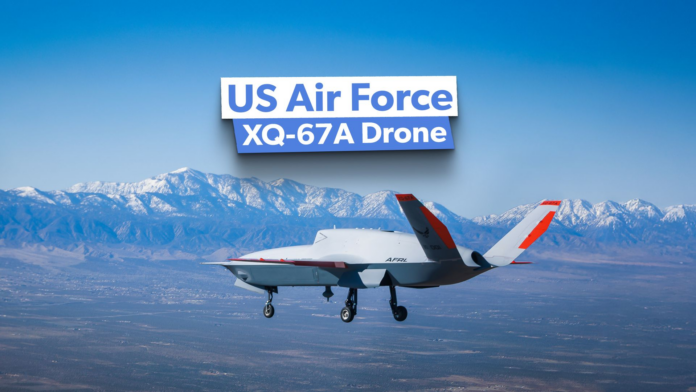The General Atomics XQ-67A is the latest unmanned combat aerial vehicle to be developed under the Collaborative Combat Aircraft (CCA) program of the US Air Force. Since 2021, the USAF has been working toward what they dub the OBSS (Off-Board Sensing Station) program to develop an unmanned combat aircraft intended to work alongside manned fighters to deliver targeting and threat intelligence.
Photo: Air Force Research Laboratory | General Atomics Aeronautical
Contracts initially included Kratos and General Atomics, but since 2023, Kratos appears to be out of the competition, making General Atomics the last man standing, so to speak. The first flight of the XQ-67A took place on February 28, 2024, and there seem to be indications that another variant is in development, which may be an OBWS (Off-Board Weapons Station) capable of using weapons.
Design philosophy of the CCA
Until recently, only limited information was available about OBSS and its intended objectives. The Air Force Research Laboratory (AFRL) has revealed more details over the past year about how this initiative built upon the Low Cost Attritable Aircraft Technologies (LCAAT), from 2014.
“We’ve been evolving this class of systems since the start of the Low Cost Attritable Aircraft Technologies initiative,” Doug Meador told The War Zone. Meador is an autonomous collaborative platform capability lead in AFRL’s Aerospace Systems Directorate, adding,
“We broke it down according to how the warfighter sees these put together: autonomy, human systems integration, sensor and weapons payloads, networks and communications, and the air vehicle.”
LCAAT paved the way for the Low Cost Attritable Strike Demonstrator (LCASD) project, through which the Air Force acquired the XQ-58 Valkyrie drones from Kratos. The XQ-58s are now regarded by the USAF as the first generation of autonomous collaborative platform (ACP),. They have been serving since 2019 but apparently have been retired by the USAF. The US Marine Corps has chosen to employ the XQ-58s in their efforts to develop new unmanned combat aircraft.
Photo: Air Force Research Laboratory | General Atomics Aeronautical
OBSS sprung from the Low Cost Attritable Aircraft Platform Sharing (LCAAPS). OBSS leveraged experience from the LCASD project, according to AFRL. The OBSS is one of two specific LCAAPS concepts to emerge, the other was called the Off-Board Weapon Station (OBWS). The OBSS was conceived as being slower but carrying more sensors and having longer endurance, while the OBWS was conceptualized as faster and more maneuverable, with shorter endurance but more maneuverable, according to remarks by AFRL.
The XQ-67A is regarded as the beginning of the Air Force’s second-generation autonomous collaborative platforms (ACP). Following the XQ-58A Valkyrie, which was the first low-cost uncrewed air vehicle aimed at delivering “credible and affordable mass for warfighters.” The XQ-67A is meant to demonstrate the shared chassis, or “genus,” approach to aircraft development. This approach is meant to the stage for producing other aircraft “species” rapidly, basing the successor generations on the same standardized “genus” platform.
“This approach will help save time and money by leveraging standard substructures and subsystems, similar to how the automotive industry builds a product line,” Meador said. “From there, the genus can be built upon for other aircraft — similar to that of a vehicle frame — with the possibility of adding different aircraft kits to the frame, such as an Off-Board Sensing Station or Off-Board Weapon Station, [or OBWS].”
Capability on a budget
The new design of the XQ-67A incorporates advanced systems and propulsion as well as superior stealth design features over the XQ-58A. The new features point to a platform prepared for expanded mission tasking, although no public information has been released about when an OBWS prototype may take flight. AFRL describes the XQ-67A as intended to serve as a low-cost attritable asset, meaning it could be sacrificed if needed to protect manned jets, troops, civilians or other high-value assets. The next obvious step is to give the XQ-67A its own means of defending itself or striking at the enemy.
Distributed deployment is another strategic power of a drone like the OBWS. Small numbers of XQ-67A drones can be deployed across a theater at multiple airfields, deploying the OBSS and OBWS on cyclical operations can saturate an area with sensors that overlap and build a complete picture of the battlespace. The key to this strategy is the low-cost and high endurance of the drone with rapid turnarounds that keep them in the air as much as possible.
Photo: Air Force Research Laboratory | General Atomics Aeronautical
The ability to take off from short runways and austere airstrips is a major factor in deployment flexibility that can be a significant force augmentation for joint forces. The option to rapidly reconfigure a drone for a different mission, say arming a reconnaissance platform to conduct a follow-up strike on an identified target, is another way that the OBSS/OBWS can work together to support USAF missions with low cost and low risk but without compromising capability. Once airborne, the different drones can coordinate with each other to share information from their sensor suites, relaying real-time intelligence to ground stations and manned aircraft as well.
Swarms of these drones could also take on the role of decoy screens, confusing enemy radar with cluttered flight paths and electronic signatures. In this scenario, manned aircraft are protected by the resulting disarray on enemy sensors. Ground command can orchestrate a single wave of unmanned aircraft dedicated to intelligence, surveillance, and reconnaissance (ISR), followed quickly by a second wave configured for electronic warfare or strike. The conflict in Ukraine, where drones have been used in large numbers to defend against Russian aircraft and troops, has shown how effective even a simplified version of this strategy can be.
Related 5 Fast Facts On The USAF Collaborative Combat Aircraft


